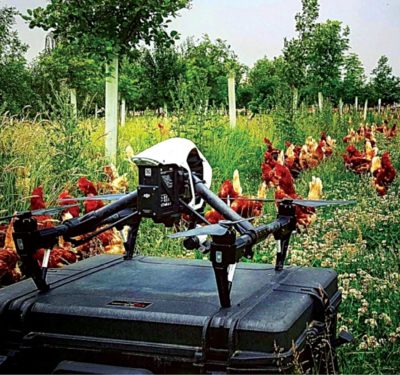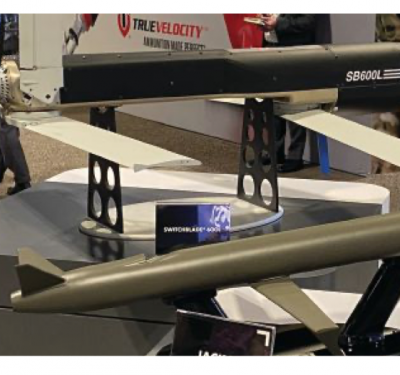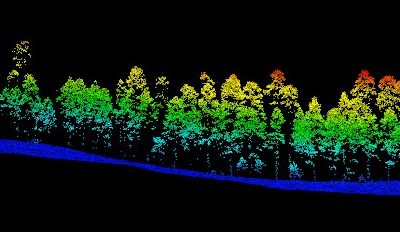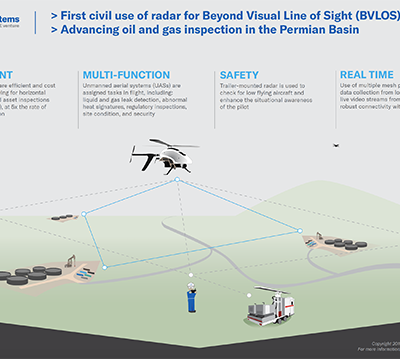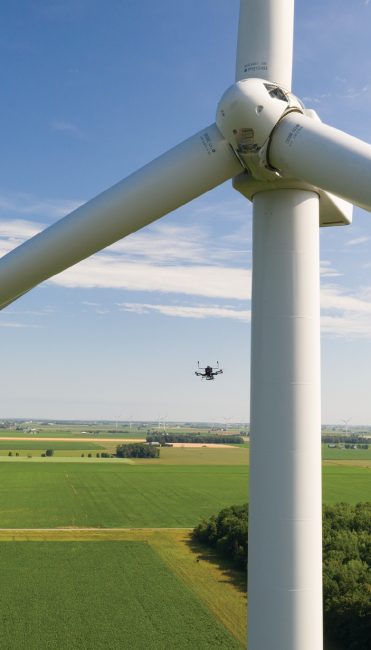
Wind power is growing by leaps and bounds, and drones are increasingly helping to keep an eye on the industry. Not content to just scan wind turbines, drone companies are finding creative ways to improve themselves, such as with predictive analyses, nested drones and, potentially, even robotic repairs.
The global installation of wind capacity is expected to reach about 705 gigawatts this year, according to market research firm Navigant Research of Boulder, Colorado. Furthermore, global wind power capacity is forecast to grow 62 percent by 2024, with onshore wind expected to grow 57 percent to 850 gigawatts and offshore wind to nearly triple to 66 gigawatts, according to a 2019 International Energy Agency report.
One driver behind this growth is how wind power is expanding into harsh environments such as sandy deserts and windy seas. Another factor is how wind turbines are getting ever larger, with GE’s Haliade-X possessing blades 107 meters long.
However, such trends are placing increasing stress on wind turbines. Sandia National Laboratories noted that more than one in 200 installed wind turbine blades fail each year. Even in temperate conditions, erosion and wear can reduce the efficiency and energy production of wind turbines by up to 5 percent.
Until recently, wind turbine inspections were typically completed manually by climbing or using long-range photography, which could prove to be slow, dangerous work. Now drones conduct such inspections more and more often, reducing climbs by up to 50 percent and inspection costs by up to 80 percent, PrecisionHawk of Raleigh, North Carolina, noted in a 2019 report.
“It has been very exciting how this industry has grown in the past three or four years,” said Harjeet Johal, CEO of drone services firm Aerodyne Measure in Washington, D.C. “Drones were legalized for civil and commercial flights just in 2016, and today between 80 to 90 percent of the addressable market in the United States is using drones for wind turbine inspection. The industry has really picked them up and embraced them very, very quickly.”
Challenges for Drones
Wind turbine inspections are obvious challenges for drones. “The typical wind farm environment is brutal over sustained, large-scale operations,” said Ben Marchionna, vice president of global operations at drone wind turbine inspection company SkySpecs in Ann Arbor, Michigan. “Blazing hot temperatures in the summer, icy cold in the winter, large amounts of dust in places like Texas and Oklahoma, or even magnetic micro-dust on some Hawaiian volcanic mountain wind farm. Not to mention high-salinity environments when conducting drone inspections on offshore wind farms in the North Sea.”
In addition, wind turbines are naturally located in places with high winds, which make numerous areas around them difficult places for human pilots to keep control over drones. “For example, when the flat surface of the blade is oriented perpendicular to the wind direction, the leeward side of that blade will experience strong vortex shedding, resulting in severe turbulence,” Marchionna said.
Moreover, the large turbine sizes also make for challenging shifts in perspective for human pilots. “The pilot is forced to look nearly straight up, as high as 800 feet or more, with many potential blind spots, and the sun often being directly behind where they must look,” Marchionna said.
“A different flavor of technical challenge is if the turbine’s brakes accidentally release or slip during the inspection,” Marchionna said. “As the blades begin to catch the wind and start moving again, they become a giant drone flyswatter. Pilots may only have one to two seconds to react.”
Autonomy to the Rescue
Given all these problems, Marchionna noted that autonomous control technologies have become critical to enabling safe operations. Johal concurred, noting that “imparting more automation has made the way that data is captured a more repeatable and reliable experience.”
“Three years ago, we were performing manual inspections of the turbines, and when the pilot was good, we got great picture quality, but if they were only somewhat okay, we did not get the greatest pictures,” Johal said. “Automation has addressed the biggest challenge we had in data capture. There is always room for improvement, always ways to get faster and more efficient, but automation has helped provide repeatable, scalable projects.”
The wind turbine inspection drones that Aerodyne Measure flies nowadays are equipped with LiDAR sensors to help them autonomously maintain position so they can focus on imaging the blades. “Before we start the inspection, we will upload a 3D model of the turbine to the drone, and the drone will use it to help maintain a fixed distance from the blades,” Johal said. “We can also transpose metadata and drone telemetry onto the images so we can know where exactly a defect is on the blade, and how big it is.”
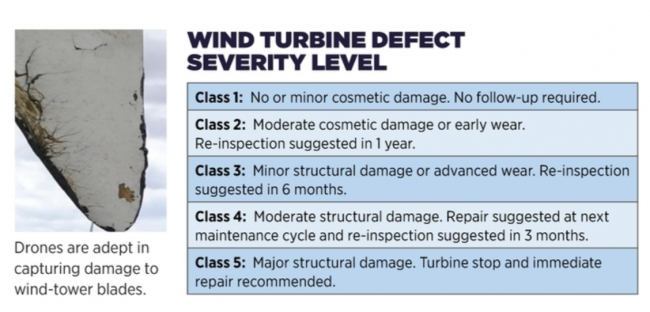
Best Practices
Drone inspections of wind turbines focus on potential structural problems with the blades, such as cracks, lightning strikes, oil leakages, erosion of the leading edges as the blades encounter airborne particles, splits along the trailing edges due to stresses on the blades, and delamination or detachment between the layers of the composite materials making up the blades. Of all these problems, “erosion, cracks and delamination are the most common, at varying points in the degradation process,” Marchionna said.
In the United States, a medium-size wind farm has roughly 50 to 100 turbines, Johal said. These inspections typically involve “about 100 pictures per blade,” Johal noted. “We do four passes on each blade, maintaining a distance of 10 to 12 feet from the blade. This takes about five to 10 minutes per blade, depending on the length of the blade. The resolution on the cameras we use is about 20 megapixels, so the measurements can be up to 1 millimeter per pixel.”
SkySpecs uses lightly modified Freefly ALTA 6 and ALTA 8 airframes to carry the company’s autonomous inspection system payload. “ALTA 6 and 8 were chosen because, at the time of selecting airframes, Freefly was the gold standard for heavy-lift professional airframes with a reputation for quality and reliability,” Marchionna said. “Our next-generation product will be a drone that is developed fully in-house at SkySpecs.”
In contrast, Aerodyne Measure uses the DJI M210 and M300 for wind turbine inspections. “We have perfected our automation and LiDAR specifications for the gimbal attached to these units, and they are quite ruggedized for wind turbine environments,” Johal said.
Inspections are performed during low wind season, “which the owners want so as to not hurt their revenues,” Johal said. “We typically fly drones when wind speeds are about 12 meters per second for that day. We can fly at higher wind speeds, but the picture quality will suffer since the drones will struggle to maintain their position at a point.”
Battery life used to be an issue for inspections “when it was limited to 20 minutes or so,” Johal said. “Now we have drones that can go almost an hour long—going from the DJI M210 and M300 more than doubled flight time. So in one flight, we can complete inspections of all three blades of a wind turbine very easily without battery changes.”
An Ounce of Prevention
Before the advent of drones, the wind industry conducted fewer regular operations and maintenance (O&M) inspections, “and a lot of times, people just reacted to catastrophic failures of turbine blades instead of trying to do something about them beforehand,” Johal said. “The industry has come a long way since then.”
Still, Johal thinks the wind power industry falls short of what he considers full preventative care. “I call what we are currently doing pseudo-preventative inspections,” he said. “When we or anyone else fly drones, we capture data, present it as a snapshot and provide recommendations to act on it. It is better than not doing anything, but it is still reactionary.”
Now Aerodyne Measure “is collaborating with industry partners to make our work truly preventative,” Johal said. “After looking at an asset for, say, three years, we know that a Class 1 issue in 2018 became a Class 2 issue over time and is now a Class 4. Based off that, we can predict, with a certain confidence level, that in the next 12 to 18 months, it can become a Class 5 problem, followed by catastrophic failure.” (See chart for more on levels of severity.)
With such predictive knowledge, “our clients can better make risk-adjusted decisions,” Johal continued. “They can have a medium-severity Class 3 erosion issue today that would probably cost, say, $3,000 to repair, and if they wait another 12 months, we can tell them there is an 85 percent chance it will progress to a Class 5, at which point they are spending, say, $20,000 on repairs.”
Such a predictive level of analysis is a challenge to achieve “given all the different makes and models of turbines, and the different weather conditions and different wind capacities they are exposed to,” Johal said. “But as we get more and more data on the same assets year after year, we are starting to move toward predictive analyses.”
Nested Drones
One future direction for autonomous wind turbine inspection may involve nested drones. “The nest of the drone is the charging station, and you would keep the nested drone at a remote wind turbine site or an offshore wind turbine site,” Johal said. “On command, the nested drone will conduct an automated inspection of the turbine, and once internet connectivity is established with the nest, the data collected will get uploaded to the cloud, and we can give the results to the client. That is the future we are working on now—more automation and autonomy, especially for remote sites where it is difficult and expensive to send people.”
Naturally, any drone company that has its machines continuously stationed at its clients’ sites benefits from the accompanying regular business afforded by these customers. But nesting has benefits for the clients as well—”it gives them more flexibility,” Johal said. “They do not need to wait on the vendor’s schedule, for them to come around and perform inspections—they just press a button, and the nested drone can do an ad hoc inspection or a fully detailed comprehensive inspection if needed.”
Repair Robots
Another possibility for drones and wind power is not inspections, but repair. Aerodyne Measure is exploring repair of wind turbines with strategic partners. “There are research and development proofs of concept already with robotic arms and other robotic assemblies applying protection on the leading edges of blades,” Johal said.
The prospect of repairing wind turbines is one “we’ve had on our radar from the start, and is also something we have on our roadmap,” said Theresa Trevor, marketing director at SkySpecs. “We believe the future of wind energy will be automated, whether through the use of software, robotics or a combination. We’re excited to play a key role in those developments.”


